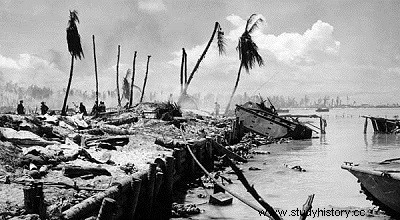
By the time Admiral Hill's ships had reached their post off Tarawa, at dawn on November 20, the Japanese garrison troops must have realized that their days were numbered. The imposing deployment of warships and transport did not prevent them, however, from giving proof of their courage. At 5:07 a.m., they opened fire with two 203 guns and tried to reach the transshipment area, about ten kilometers from the atoll. Led by Hill's flagship Maryland, firing all her 406 guns, the 3 battleships, 6 cruisers and 9 destroyers of the supporting force concentrated their fire on Betio. The Japanese shore batteries were quickly silenced by the avalanche of iron and fire. Huge masses of smoke and dust then rose from the island, as ships periodically suspended firing to give way to bombers and fighters from carriers.
At sea, the men of the landing party, the 2nd Marines, reinforced by a battalion of the 8th Marines, were transferred from their transport buildings to the LVTs and landing craft, LCVPs (carrying the guns) and LCMs (with the medium tanks), which lined up before undertaking, in fairly rough seas, the approach which would extend over 5 kilometers to the starting line inside the lagoon. General Smith had in fact decided to approach the island-fortress by the beaches which were the least likely to be mined; aerial reconnaissance had reported that the Japanese had used them until the last moment.
Preceded by two minesweepers, which acted as command ships, the amtracks and the landing craft entered the lagoon along the cleared channel between two edges of coral reefs. As soon as the Japanese coastal batteries wanted to open fire on the barges of the first wave, two destroyers, which had also entered the lagoon, silenced them. But the journey had been long since the transport ships and the barges had been delayed; Admiral Hill was therefore obliged to postpone zero hour until the waves had aligned in the lagoon.
Three beaches — Red 1,. 2 and 3 , each assigned to a sub-group, succeeded each other and respectively occupied the beak, the neck and the belly of the bird which represents
As for the legs, they extended over some 500 meters; they consisted of a stone jetty overlooking the barrier reef at its closest point to shore. This was cleared by a daring commando of snipers who set foot at the end of the pier at 8:55 a.m. and systematically destroyed all structures likely to harbor enemy weapons.
State of minds in Rome and Carthage However, hopes and anxieties grew more lively day by day:it was unclear whether to rejoice that Hannibal, evacuating Italy after sixteen years, had left possession of it in peace to the Roman people, or rather to alarm that he had crossed into Africa without havi
